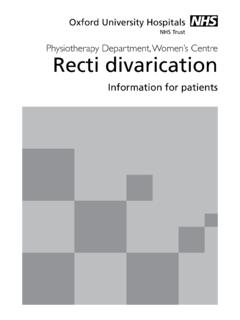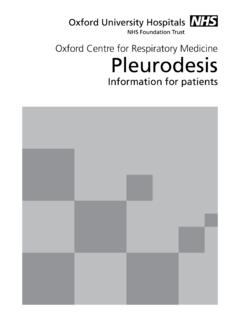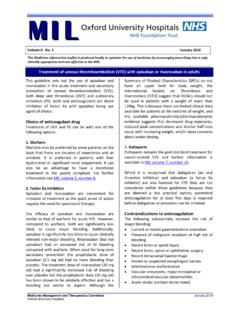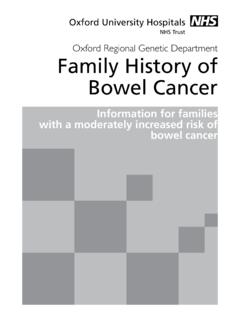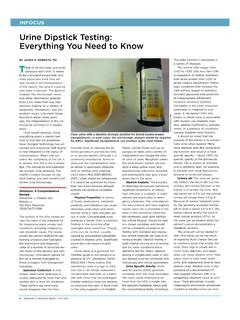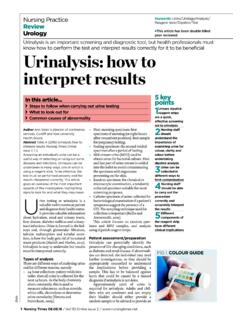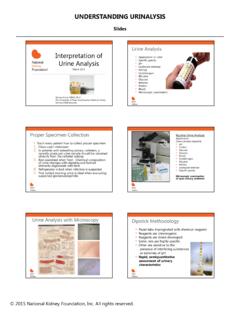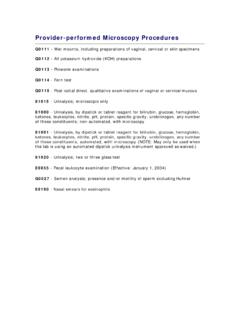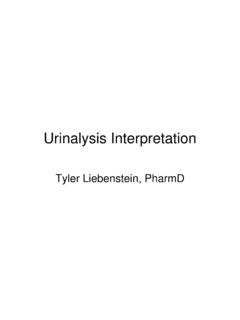Transcription of Investigation of adult haematuria in Oxfordshire - ou h
1 Investigation OF adult (> 18 years old) haematuria IN Oxfordshire IN PRIMARY AND SECONDARY CARE Jeremy Crew and David Lewis haematuria is a common symptom (macroscopic) or sign (microscopic) which forms a considerable burden within primary and secondary (urological) care. The risk of this being a manifestation of significant underlying disease (including cancer) varies according to the age (risk increases with age), sex (male patient are more often found to have significant disease) and type of haematuria (macroscopic has a higher positive predictive value for significant disease than microscopic). TABLE 1 CAUSES OF haematuria Urological malignancy (BLADDER, prostate and kidney) Urinary Tract Infection Renal stone disease Benign prostatic disease (including prostatitis, BPH) Non-infected inflammatory cystitis Glomerulonephritis & other renal conditions A cyst bleed in ADPKD Trauma (causing haematuria or myglobinuria) Exercise-induced haematuria (more common in patients with IgA nephropathy) Renal infarction (rare) Tuberculosis of renal tract Uncontrolled systemic anticoagulation In writing these guidelines it should be stressed that there is no consensus within the literature as to who should be investigated or how they should be investigated.
2 This document has been developed for guidance purposes and the advice outlined should be tailored to individual patients needs taking into consideration the patient s age, comorbidity and the patient preference once the risk of finding underlying pathology has been conveyed to them. The guidelines have been generated in consultation between urology, nephrology, radiology, microbiology and pathology and aim to present a succinct and pragmatic management strategy for haematuria in Oxford. The questions addressed include; 1] What is significant haematuria ? 2] Who should be referred urgently? 3] How should patients be referred? 4] What imaging is required? 5] What other tests are required? 6] Who should be referred to nephrology as opposed to urology?
3 7] What investigations should be organised in primary care prior to referral? MACROSCOPIC HAMEATURIA Painless macroscopic haematuria is a significant symptom and should be investigated in all cases unless a definite cause for the bleeding is known. Urinary infection must be excluded prior to referral. If a urinary tract infection coexists with the macroscopic haematuria then this should be treated as appropriate and the patient reassessed and referred if haematuria persists. Certain benign conditions may discolour the urine (Table 2). Whilst these should be borne in mind these rare causes should not be used as an explanation for haematuria and if doubt exists referral remains mandatory. TABLE 2 Benign conditions that may discolour the urine Mensturation Jaundice Ingestion of foodstuffs (beetroot, red cabbage) Dyes (paprika, other food colourings) Drugs (rifampicin, metronidazole, nitrofurantoin, warfarin, phenytoin) Some gram negative bacteria (possessing indoxyl sulphatase) Rhabdomyolysis Rare metabolic disorders (porphyria, alkaptonuria) It should be emphasised to patients that even if the macroscopic haematuria settles or is an isolated event then referral and investigations are still required.
4 Anticoagulation is more likely to provoke rather than be the cause of haematuria and as such referral remains necessary Referral route All patients with macroscopic haematuria in the absence of urinary infection should be referred under the Cancer 2 Week Wait to Urology. Patients above 30 years old will be directed (via the call centre) directly to the Macroscopic haematuria Clinic (for flexible cystoscopy and imaging, see flow diagram). Patient less than 30 years old will be directed via the call centre to an urgent outpatient appointment with urology for review prior to Investigation . In this young group of patients cancer diagnosis is rare and cystoscopy under local anaesthetic may not be tolerated or acceptable.
5 Within the outpatient setting the need for cystoscopy (under general or local anaesthetic) and upper tract imaging modalities will be discussed and arranged as appropriate. Investigations If the decision is made (within primary care) to refer a patient to secondary care then pre- Investigation can be limited to blood tests and urine midstream urine for microscopy, culture and sensitivity only. It is not necessary for imaging or urine cytology to be organised within primary care. 1] Blood tests: Urea and electrolytes and creatinine Glucose eGFR PSA (see appendix to flow diagram) 2] Urine tests: Mid stream urine for microscopy, culture and sensitivity 3] Urine cytology: If a patient is to be referred to urology we would not recommend that urine cytology is performed in primary care.
6 Urine cytology or another urine marker will be performed at the haematuria Clinic if other investigations are normal 4] Cystoscopy: This is mandatory and usually involves a flexible cystoscopy under local anaesthetic (gel instilled into the urethra) in the outpatient setting as part of a haematuria clinic. This is acceptable to the vast majority of patient although GA cystoscopy may be necessary in a small number of patients (especially in young patients eg < 30 ). 5] Upper tract imaging: CT Urography (CTU) represents the gold standard imaging modality for haematuria . CTU will be performed in most patients over 40 yo. In patients less than 40 yo a decision will be made by the consultant radiologists as to the best imaging modality and this may involve a combination of USS and IVU.
7 This decision will be made based upon the radiation dose and access to CT slots . Further investigations may be required (eg retrograde urography, follow-up CT, arteriography) in a small percentage of patients depending upon the initial findings or persistence of symptoms. These will be arranged within secondary care. 6] Urinalysis: Urinalysis is not necessary as part of the work-up of patients with macroscopic haematuria . It will be performed at the time of the haematuria Clinic to exclude significant proteinuria. Referral to nephrology Most patients with macroscopic haematuria will require cystoscopy and imaging to exclude a post renal cause (including malignancy) for their haematuria .
8 As such the primary referral route should be to Urology. Referral to nephrology will be considered within the secondary care setting in patients with significant proteinuria (greater than 2+), abnormal renal function (eGFR < 60mL/ ) or imaging findings suggestive of primary renal disease. TABLE 3 Common nephrological causes of haematuria IgA nephropathy Alport s Syndrome Thin Membrane Disease Acute glomerulonephritis adult polycystic kidney disease Vasculitis Factors within the patient s history that may indicate a renal or prerenal cause for haematuria include; 1] Family history of renal disease; hereditary nephritis, polycystic kidney disease, sickle cell disease 2] Nephrotoxic drugs 3] Constitutional symptoms (weight loss, fevers, sweats, malaise, arthralgias), suggesting systemic conditions including vasculitis 4] Persistent exercise induced haematuria If there is strong evidence suggesting a primary nephrological disorder then urgent referral to nephrology remains an option.
9 MICROSCOPIC haematuria Microscopic haematuria can be diagnosed either on urine microscopy or dipstick urinalysis (aka dipstick haematuria ). Whilst formal urine microscopy will only show intact red blood cells, dipstick tests do not distinguish between intact red blood cells in the urine, free haemoglobin in the urine (caused by intravascular haemolysis), or free myoglobin in the urine (caused by rhabdomyolysis). False positive dipstick can occur with: Heavy bacteriuria semen extremely alkaline urine (pH > 9), as caused by oxidising agents used to clean the perineum extremely dilute urine (specific gravity < ) Referral is not recommended for a single finding of microscopic/ dipstick haematuria .
10 Significant microscopic haematuria requires an element of persistence with haematuria demonstrated in 2 out of 3 separate and correctly collected dipstick / microscopy tests. High grade dipstick haematuria ( ++ or above) has a high positive predictive value (PPV) for RBC in the urine and does not require confirmation on microscopy. However the PPV is less when dipstick analysis comes back as Trace or + . In these patients it is recommended that the presence of RBC is confirmed on microscopy on at least 1 occasion prior to referral. There have been various levels suggested as to what constitutes significant microscopic haematuria , however within the Oxford Radcliffe Hospital Trust it has been agreed that >10 RBC per microlitre would be required to signify significant microscopic haematuria .
